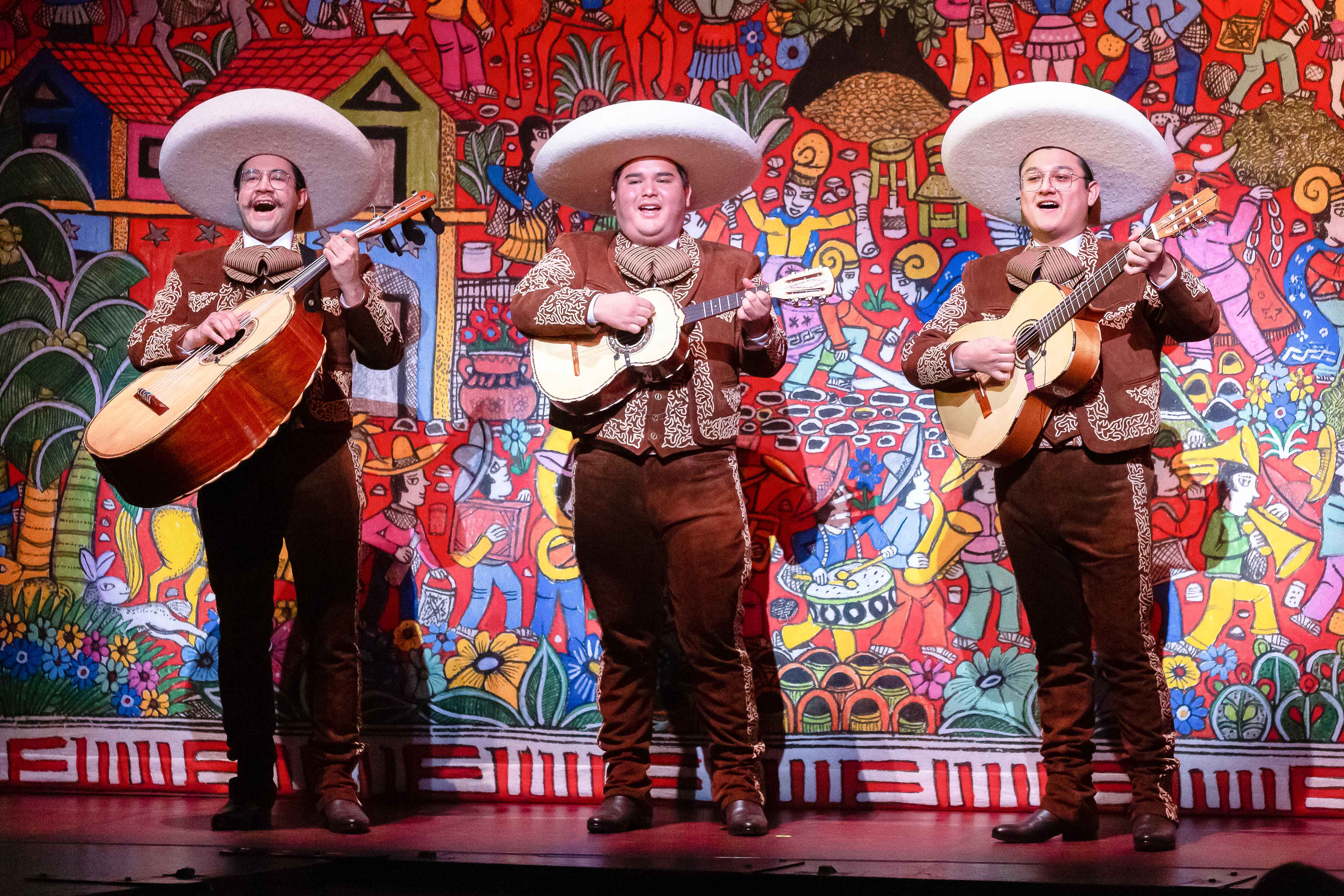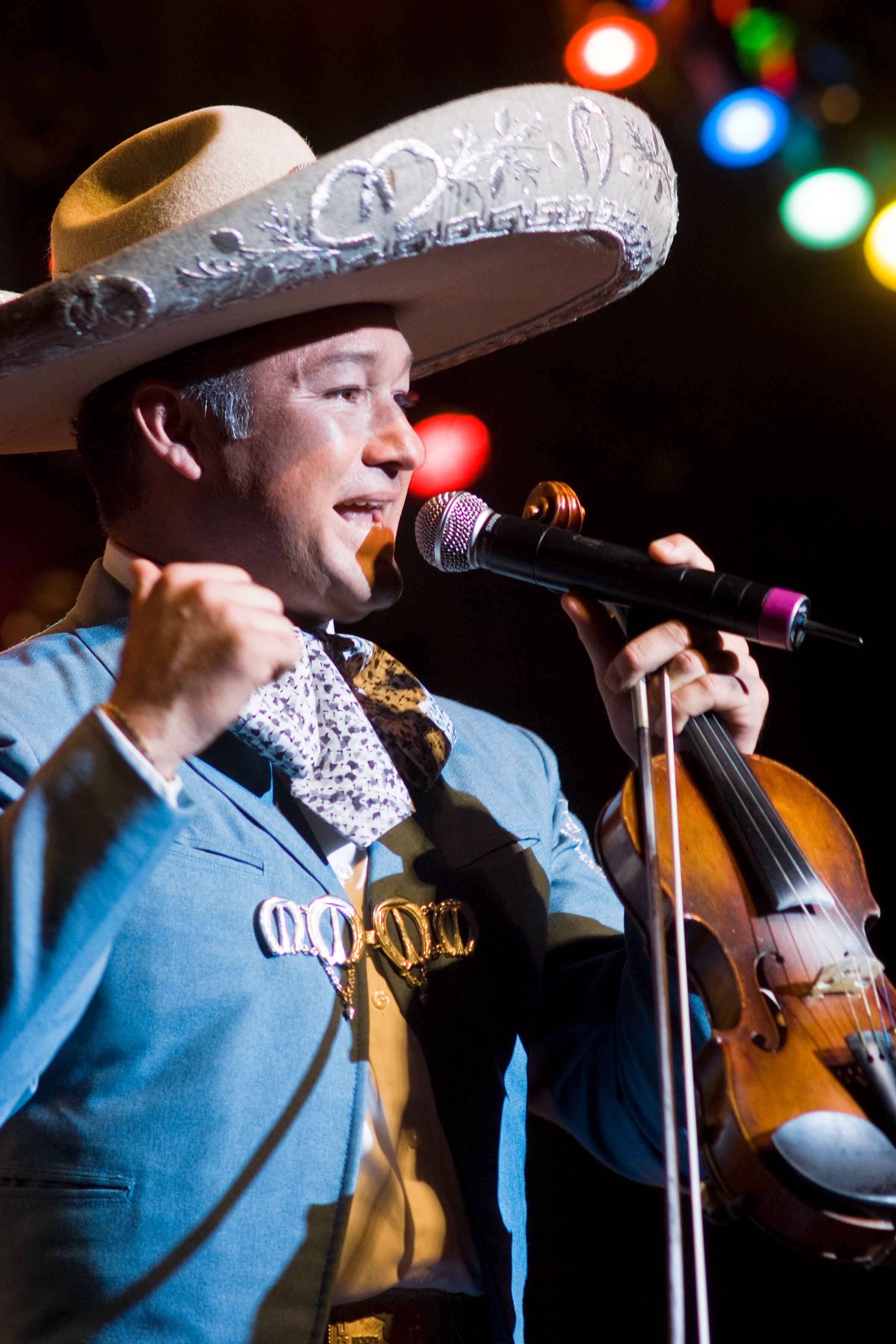Mariachi at HGO
In opera, the composer leads everything, and all roads of our mariachi research led to the same famous name: Mariachi Vargas De Tecalitlán, unquestionably the Rolls-Royce of mariachi orchestras, and most especially to their leader, the late José “Pepe” Martínez (1941-2016), a musical legend in Mexico. Pepe and his forces enthusiastically signed on and set to work with Lenny, also committing Mariachi Vargas to perform as the orchestra for the original Cruzar. Coming from our insular opera world, little did we know that Mariachi Vargas would need a V.I.P. private arrival at Bush Intercontinental, to avoid being mobbed; these guys are famous.
I don’t think I’ve ever heard an audience in the Wortham scream louder for anything than the audience for Mariachi Vargas.
Milagro was composed by Pepe Martínez’s son, Javier, to a libretto by Leonard Foglia, and it was very much a musical tribute to his late father. The writing of the mariachi operas, and there are so far only these three in the world, has become an important part of the Martínez family legacy. How special that this moving multi-generational story of a loving family has been composed by a multi-generational loving family.
All three of our mariachi operas share common themes, and should be thought of as a cycle that presents a cross-section of historic ties between Texas and Mexico. Cruzar is set in both the present day and in the memories of previous generations of the Velásquez family. The second mariachi opera, El Pasado Nunca Se Termina (The Past Never Ends) takes place during the appearance of Haley’s Comet in 1910, on the eve of the Mexican Revolution, and within it mariachi takes on its political “voice of the people.” Our dear El Milagro de Recuerdo is a touching prequel to Cruzar, telling the story of the last Christmas the Velásquez family spent together in Mexico before their immigration to the U.S. Milagro is a holiday story, filled with the traditions of Christmas in the Mexican state of Michoacán, a place unknown to many Americans though they are not far away: the beautiful Michoacán Mountains are the same distance south of Houston as St. Louis, MO is north.

Operas during the holidays are, historically, a mixed bag, as the art form carries some particularly loaded cultural baggage. Many people associate opera with heavy themes, and let’s face it: a lot of characters die in opera, and there’s lots of angst, so little in the history of opera conjures thoughts of candy canes, snowmen, or Santa Claus, much less Hanukah, Christmas, or Kwanza. The other performing arts have “holiday” works of various kinds—Messiah, A Christmas Carol, The Nutcracker—but not opera. Often, opera companies will perform the supposedly family-friendly Hansel and Gretel in December. Undeniably, it is one of the greatest operas in the repertoire, but what within Hansel and Gretel puts people in a holiday mood? Is it the cannibal witch who kidnaps children, or the starving children who kill her to save their own lives? Ho! Ho! Ho! HGO has commissioned a number of holiday operas, and time will tell which of them may find an audience. The Nutcracker, remember, sat in complete obscurity for 50 years after it was written, and remains a uniquely American holiday phenomenon. Audiences decide, but often not immediately.

Though the stage story of Milagro is fictional, it is the real story of countless Mexican families. Milagro is set in 1962 during the Bracero Visa Program, a U.S. immigration policy from 1942-64 which allowed Mexican workers to legally enter the U.S. for short-term work, multiple times, and return to their families. It was the largest labor program in U.S. history, and those who participated in it, the braceros, still feel a unique bond with each other and with the U.S.
In the plot of Milagro, a small mountain town in Michoacán is preparing their Christmas pageant, a pastorela, in which Saint Michael the Archangel is subduing a satirical and only-slightly-scary Satan, who is vying for the souls of a group of shepherds on their way to Bethlehem to meet the newly-born Jesus. Multiple generations of the family take part in the pageant.
Christmas traditions in Mexico are unrecognizable to many of us in the U.S., and Milagro brings many of them to joyous life. While we are accustomed to Christmas music and merchandise appearing as early as October and our holiday decorations barely make it to New Year’s Day, in the oldest Mexican traditions the holiday season begins on December 12 with the Feast Day of the Virgin of Guadalupe and stretches to February 2 with the Día de la Candelaria (Candlemas). During that time there are the many celebrations of Las Posadas, including processions in which children dress as Mary and Joseph and the shepherds; families sharing star-shaped piñatas with seven points, one for each of the cardinal sins; and most famously, feasts of Mexican treasures such as buñuelos, atole, ponche, mole, bacalao…such deliciousness.
Mariachi is, beyond everything else, pure musical joy, and it has a unique ability to invite everyone into its embrace. I have an indelible memory of attending the last performance of Milagro in December of 2019, shortly before the pandemic reordered our world. I was seated next to a very nice Houston grandmother with whom I had a long conversation before the opera; she was a first-generation immigrant from Michoacán. She leaned over to me in tears during the opera’s finale and said, “I never thought I would see my life on stage in an opera.” El Milagro warms the heart, and we could not be more delighted to have it back on our stage. Javier Martínez, who wrote its tuneful score, said it best: “As soon as you leave, you will want to see your parents.” Happy Holidays.
Musicians trained in the European tradition, which is to say all of us classical musicians, probably went through our whole expensive education without hearing the word mariachi. This omission has distinguished company: we probably didn’t hear the words Gnawa, Giacomo Puccini, gamelan, or desi sangeet, either—as all of these are generally grouped together as “popular,” and classical music is notoriously glacial about catching up with the rest of the world. One thing is certain: mariachi is the most cherished music of our Mexican neighbors, and though it has origins stretching back centuries to Spain, it is utterly unique to Mexico. Mariachi speaks right to the heart, which is why it has held such popularity for so long, and it has the immediacy for us now that Italian opera had at its height.
Until fairly recently, mariachi orchestras were solely string instruments, some bowed and some plucked, including specifically Mexican instruments like the jarana and vihuela—both of them five-string guitars—and the guitarrón, a full-sized bass guitar. You hear all of these and more in a very special opera this season in its first HGO revival, El Milagro de Recuerdo (The Miracle of Remembering). Mariachi trumpets, now so associated with this music, are relatively new to mariachi orchestras, as are saxophones and other additions. Mariachi, uniquely, always sounds like it was just written, whether it is new or old.
Mariachi has always included a lot of singing, but incredibly, until HGO commissioned a mariachi opera, the tradition had not included narrative songs like one would find in musicals or operas. It was former HGO General Director Anthony Freud who, on a holiday in Oaxaca, 300 miles southeast of Mexico City, had the original idea for a mariachi opera, the first of which was Cruzar la Cara de la Luna (To Cross the Face of the Moon) which HGO premiered in 2010.
Since Anthony’s idea was a broad one—“what if we wrote a mariachi opera?”—it required some research as to who should compose the music and write the story. Veteran stage director Leonard Foglia, who lived in Mexico at the time, was asked to think about a story and a potential writer, and his quick email reply outlined what became the beautiful story of what would become Cruzar. He happily wrote the libretto himself. There are countless mariachi orchestras in Mexico and throughout the United States, but we didn’t simply need musicians; we needed creators.
Mariachi is beyond everything else, pure musical joy, and it has a unique ability to invite everyone into its embrace.